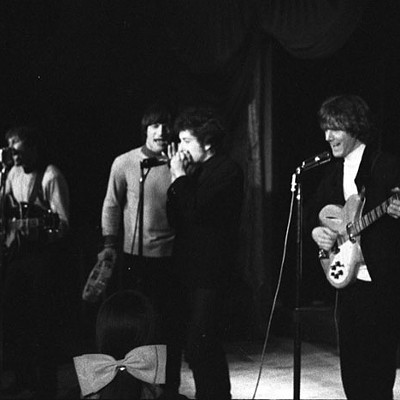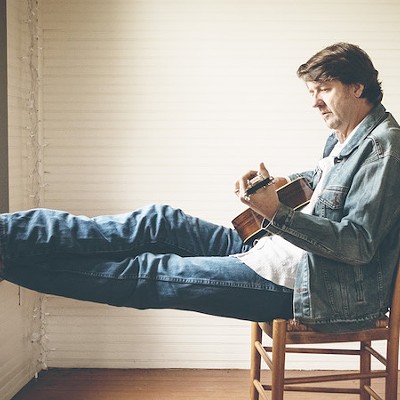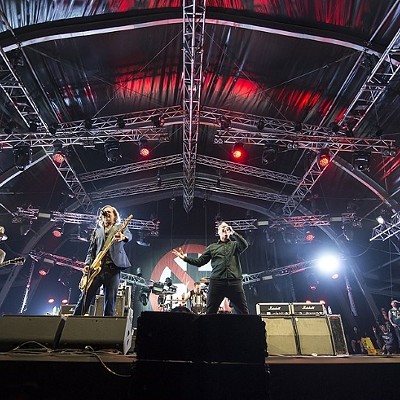Many photographers, myself included, are sometimes guilty of using cameras as blunt instruments: documenting only singers-cum-heroes at a gig, as if bands were no more than rock and roll puppets temporarily, but powerfully, occupying one’s attention. Ben DeSoto, though, has always approached concerts at clubs, bars and warehouses more holistically. He understands the fluid interchange between audience and performer — the absolute vibration of those moments caught in space and time. In the mise-en-scène of his roving camera eye, the gig is an immersive, decentralized space in which the audiences are just as performative, interesting or meaningful as the people unleashing the music.
Poring over DeSoto's negatives shot throughout three decades, one glimpses how people within the punk community are often not mere passive onlookers; instead, they are smoldering, fidgeting, undulating, atavistic, dance-prone and catapulting. They are a tempest tethered to musicians via an invisible umbilical cord. As bands reach dizzying magnitudes, bodies in the crowd surge and search for release, pleasure and locomotion.
Yet, other times crowds seem remote, languid, colorless, drained. But perhaps that is merely a way to spell out their boredom, autopilot reactions or mesmerism. Above all, DeSoto’s visual narratives speak to his skills and artfulness. Since DeSoto has been focusing on prison reform, the culture of poverty and inner-city education for years, David Ensminger, whose books Visual Vitriol and Mavericks of Sound feature key photos by DeSoto, caught up with the iconic photographer long enough for this exchange.
Houston Press: First, how did photography become your passion — was it something innate, or something triggered by a book, teacher or work you saw?
Ben DeSoto: My passion was awakened in high school. My high-school English teacher — Homer Brown — trained in the Air Force as a photographer and converted a janitor’s closet under a stairwell into a darkroom. After witnessing the “scientific magic” of watching a print come into being in a developing tray, I have been hooked ever since. Today, as a teaching artist, I am teaching Visual S.T.E.A.M. My goal is to teach a visual language that highlights science, technology, engineering and math through the art of photography and filmmaking.
When you began at the Houston Post, were you basically covering "the beat," the daily news or also documenting arts, culture and social-justice issues, like your contemporary focus?
The summer of 1980 was a milestone in my career. I started an internship as a staff photographer at the Post. Joined the staff full-time that fall and was able to wrangle an invitation to join the Houston Chronicle in September 1981. I handled any and all assignments. “I photographed fires, explosions, lots of human tragedies and occasional human triumphs” could be my caption. Music was a minor topic for the papers. Sports, spot news, society columns and standalone features, wild art, and weather shots were the publication’s priorities.
My current focus of interest on homelessness is born out of the general oeuvre of assignments and is currently in the form of the documentary film Quiet Storms of Reform, which highlights and showcases the reforms in our courts, health care, and foster care delivery. These reforms are contrasted to the story of two people I met in 1988, so we have worked over the past three decades in creating a deeper understanding of the underlying causes of chronic poverty. If today’s reforms and the work of applying the Houston First model across the country had existed 40 years ago, the lives of homeless locals Ben White and Judy “Snow” Pruitt, who I began documenting in 1988, as well as the lives of Pruitt’s daughter Antoinette and her children, plus the lives of thousands of other Americans, would have been much different.
In 1980, when the Post assigned you to cover both the Island and Raul's, what was the immersion and documenting like for you — a whole new world, or did you have feet in the scene already?
Gosh no. I was raised in a typical fundamentalist [Southern] Baptist church community. I will add, while the neighborhood and church spoke Spanish, my parents practiced an English-only policy with little sister and myself. That decision was based on the troubles they and older siblings faced in Pasadena, Texas. So, not only were we one of a handful of Protestants in a Roman Catholic neighborhood, where all the Mexican-Americans found ourselves living, I wasn’t a native speaker. In 1978, I made a decision that I would better serve the Lord as a photojournalist than as a minister. This did lay a foundation for my love of punk music the first time I heard it in the summer of 1980. It sounded like I felt: a sense of isolation and despair; excited just to be alive; a questioning of authority.
However, the story about “that new fangled music scene” began as a self-assignment, as I sought out reporters for stories to work on that first summer. Finishing at the University of Houston journalism program under Ken Kobre, I hit every assignment like I was shooting for Life magazine. I certainly used the secondhand gear I bought off Post staffers to light up the cavernous clubs.
When the photos of the Big Boys (a gig with the Inserts) at the Island ended up in the pages of the Houston Post, for me, that's a kind of "coming out" of punk music locally, at least in the citywide media, as your shots of Christian Arnheiter of the Hates suggest, too. You were photographing Really Red and more, too. Did it seem like a kind of cultural epoch/renaissance was unfolding?
I like to think of my best work results [from] intuitive photography. I have this whole essay about what makes photography fine, and picked up the nickname “zendfoto” because of the decisive moments of human interaction. I shoot everything as “front page news”: I try to see both the moment in the here and now, and place that moment in the context of eternity, the universal humanity of being, plus the future as foreshadowed in the present (intent and the relationship between hope and despair). Fortunately, I really don’t think about this. I just observe and shoot.
One compelling side of your work is the extensive focus on audiences, rather than bands entertaining. Your eyes seemed to roam Raul's, Rock Island/The Island, Parade, Axiom, Cabaret Voltaire, etc., as if the performance were actually the audience itself. Why this approach?
Just doing my job. Action and reaction. Overall medium: detail. Observational detail. High angle, low angle. Before and after. The moment. A “scene” is all subject-society. With a little more formal research, I have become an anthropologist.
I've seen you host workshops with students, and your focus is often "one shot can change the world": More than providing mere technical tips, you seem to suggest students can engage and stir culture from their own POV. Has this been your consistent modus operandi?
YES! YES! YES!!!! My foundation as a journalist has been communication. Formally, as a member of the Fourth Estate, I am a professional, trained, curious mind. This is merely structure to a human capacity. I like to articulate the idea of being a citizen journalist, which offers a natural balance in order for the United States to function. Two great examples of this self-revelation made into public discourse are the Arab Spring and the use of citizen video to counter the “official police version” of recent events. As an American, I am of the opinion that it is not merely a privilege, nor a mere right, but a RESPONSIBILITY to bear witness to the truth. Even the thief dying next to Jesus on the cross was blessed with Paradise when he spoke about the injustice of an innocent man given a death sentence. Is that true salvation for any human being? People should be able to see and speak the truth of what is happening to and around them.
You've documented many more traditional bands as well, like ZZ Top, and rappers like Geto Boys and Public Enemy, yet the documentary you are producing focuses on the Island and includes Mydolls, Hates, Legionaire's Disease and others. Why does this club, and the bands, speak so powerfully to you?
Yes, currently Nights at the Island has grown from an idea as a short film by a fan who uses street interviews and the medium to display photographs. We — a semi-organized editing collective or something — have five vintage videos by the Video Boys, a.k.a. Dale Brooks; bunch of flyers from you; 40 kick-ass minutes of a four-camera edit of an Island reunion performance at Walters in 2012; 20 minutes of responses to favorite Island memories and the significance of the venue; and interviews with former staff at the now-vacant lot of the club. This includes an interview with Dale, who we lost this past year. My friend Torry Mercer is going to work on it next. The project got bigger, and I got busier with Quiet Storms.
More recently, you've focused on issues like prison reform, combining photography and activism, and your work covering homelessness is extensive, too. You've talked about communities of trauma incubating behaviors and outcomes. Did punk's emphasis on politics and social awareness push you in this direction, or did it stem from elsewhere?
It is like second-source verification. I was so glad to get some perspective and backup stories. “Teaching You the Fear” by Really Red has always motivated me to make common the knowledge that some cops are bad cops. An informed public can make informed decisions, which can impact public policy and social practice. People need to know that prisons are creating the “underclass” they are bitching about.
To understand how states of trauma and post-traumatic stress affect communities, read Paulo Freire’s Pedagogy of the Oppressed; the stories of Job, the prophet Hosea and his wife Gomer in the Bible; and the four directions of response to the poverty of East London in the 1800s — Charles Dickens; Karl Marx; Methodist William Booth, who founded the Salvation Army; and the Barnetts, who started the Settlement House movement.
Both George Orwell and Jack London, as young men, made such conditions including the East End in their observations, as topics of their first published work, which also addressed the state of poverty and the life of the have-not’s. These pockets of poverty are “cultures of despair”: They lack medical care, opportunities for work at a living wage, and affordable housing, plus healthy food and a strong education. Our chronic homeless come from families that are shattered, unable to care for family members in need, and problems like a quality education. For example, does it bother anyone that freed slaves bought a park to celebrate emancipation, yet the Houston City Council renamed the bounding street after Richard Dowling, a Texas Civil War hero, two years later? Such history matters.
DeSoto will begin fundraising for his Quiet Storms of Reform documentary next Thursday, January 21.
Support Us
Houston's independent source of
local news and culture
account
- Welcome,
Insider - Login
- My Account
- My Newsletters
- Contribute
- Contact Us
- Sign out
Legendary Houston Music Photographer Ben DeSoto Opens His Punk-Rock Vaults
David Ensminger January 14, 2016 6:00AM
[
{
"name": "Related Stories / Support Us Combo",
"component": "11591218",
"insertPoint": "4",
"requiredCountToDisplay": "4"
},{
"name": "Air - Billboard - Inline Content",
"component": "11591214",
"insertPoint": "2/3",
"requiredCountToDisplay": "7"
},{
"name": "R1 - Beta - Mobile Only",
"component": "12287027",
"insertPoint": "8",
"requiredCountToDisplay": "8"
},{
"name": "Air - MediumRectangle - Inline Content - Mobile Display Size 2",
"component": "11591215",
"insertPoint": "12",
"requiredCountToDisplay": "12"
},{
"name": "Air - MediumRectangle - Inline Content - Mobile Display Size 2",
"component": "11591215",
"insertPoint": "4th",
"startingPoint": "16",
"requiredCountToDisplay": "12"
}
,{
"name": "RevContent - In Article",
"component": "12527128",
"insertPoint": "3/5",
"requiredCountToDisplay": "5"
}
]
KEEP THE HOUSTON PRESS FREE...
Since we started the Houston Press, it has been defined as the free, independent voice of Houston, and we'd like to keep it that way. With local media under siege, it's more important than ever for us to rally support behind funding our local journalism. You can help by participating in our "I Support" program, allowing us to keep offering readers access to our incisive coverage of local news, food and culture with no paywalls.
David Ensminger
Trending Music
- Country Rock Thrives with Gene Clark and Flying Burrito Brothers for Record Store Day
- Bruce Robison Is The Eternal Song Hunter
- Low Cut Connie Keeps One Foot In The Gutter
-
Sponsored Content From: [%sponsoredBy%]
[%title%]

Don't Miss Out
SIGN UP for the latest
Music
news, free stuff and more!
Become a member to support the independent voice of Houston
and help keep the future of the Houston Press FREE
Use of this website constitutes acceptance of our
terms of use,
our cookies policy, and our
privacy policy
The Houston Press may earn a portion of sales from products & services purchased through links on our site from our
affiliate partners.
©2024
Houston Press, LP. All rights reserved.




